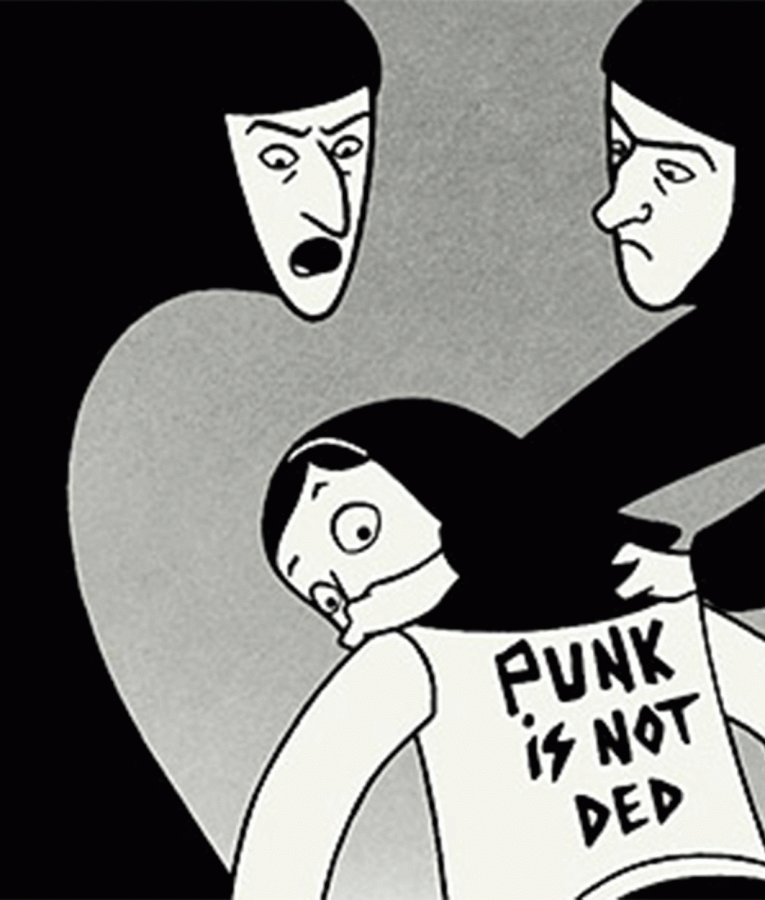Friday Film Series Features Living Writer’s Work
A two-dimensional black and white film might not seem captivating, but “Persepolis” is not your average movie. Featured in the Friday Night Film series on October 31, it tells the life story of Marjane Satrapi, who was at Colgate the day before as part of the Living Writing Series. Her graphic novel autobiography of the same name served as the source material for this movie adaptation.
The Iranian Revolution and Iraq-Iran War serve as the backdrop for this coming-of-age story. Satrapi is a little girl living in Tehran in 1978 amidst the Revolution when the film begins. The revolution affects everything around her. Her grandfather is in prison for being a communist, and her family is critical of the Shah, a ruler said to be chosen by God. Violence occurs daily in the streets outside of her home. Satrapi is taught in school to support the Shah, but she quickly learns from her parents that his system is one of destruction and inequality.
Despite such a grave situation, Satrapi still enjoys her childhood. Surrounded by strong adult figures, her naturally inquisitive and outspoken nature is encouraged by her family. Every devilish idea is accompanied with a wide grin and raising of her cartoon eyebrows. Her Uncle Anounche is let out of prison nine years after the Shah is overthrown, and Satrapi demands to know what happened to him. Instead of shielding her from the truth, he tells her of the cruelties he underwent. The family is worried about him, about Satrapi and about the future of their country. Iraq attacks Iran one year after the revolution and the new government that takes its place is even more oppressive. When Uncle Anounche is captured again, he asks to see Marjane one last time before he’s murdered. His death serves as a catalyst for Satrapi’s journey into adulthood.
By 1982, she has adjusted to life under the new regime. Women are forced to wear veils and cover themselves. Using deodorant and makeup is prohibited, along with consuming alcohol and wearing nice clothes. Foreign music by artists such as Michael Jackson is illegal to own, but Satrapi buys an Iron Maiden album illegally from a vendor on the streets. She is fully consumed by punk culture and its nonconformist attitudes, even going so far as to wear a handmade jacket with “Punk Is Not Ded[sic]” written on the back. Her dangerous behaviors almost get her killed and her parents send her to boarding school in Austria to protect her. Isolated and unable to truly connect with people who don’t have the same appreciation for life and their freedom, Satrapi ends up homeless after pushing everyone away. Finally, she returns home exhausted and detached, an empty shell of her former self.
“Persepolis” portrays Satrapi’s growth, development, decline and regrowth during a politically unstable era in a way a three dimensional film with real actors would not be able to capture. The cartoon style enhances the experience, often adding comedy or even drama to different scenes. Satrapi is a remarkable character with an incredible support system from her parents and her feminist grandmother, who encourages her to get a divorce after marrying a deadbeat boyfriend simply to be able to go out in public with another man.
Satrapi eventually follows her dream and relocates to France, where she wrote her graphic novel and had the opportunity to write and direct this film. “Persepolis” is the stunning account of her life, and her spirit will certainly inspire any viewer.







